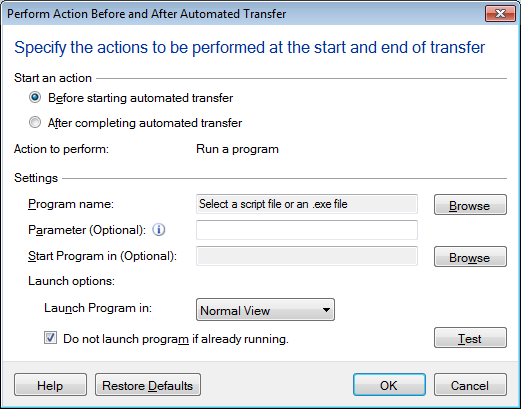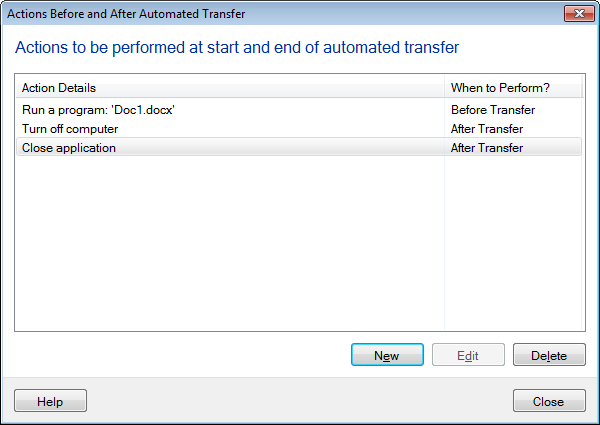Automated Transfer Rules
Automated Transfer Rules tells Auto FTP Manager what operations to perform while executing an Automated Profile.
While creating a profile, define all the rules and let Auto FTP Manager execute the profile according to these rules. In the Automated Transfer rules, you can:
-
Select the actions to perform such as Transfer, Transfer and move, Transfer and Delete, Synchronize or Delete. Delete options helps you to choose which files to delete.
-
Rename the files after transfer on destination using rename rules.
-
Decide the Conflict resolution method that needs to be applied when file with same name is already present at the destination location.
-
Include only important files by configuring filters. Auto FTP Manager will choose only these files for the automated process.
-
Run the same profile at a particular time by configuring the schedule.
-
Select actions to perform before or after completion of transfer or turn off computer once the automated transfer is completed.
-
Save and send the transfer report once Automated process is completed.
To add different Automated Transfer Rules to your automated transfer profile, right click the profile and select Edit Connection Profile >> Transfer Rules. You can specify any or all of the following Action Rules:

Action Rules
In an Automated Transfer Profile, Action Rules tells Auto FTP Manager what operation to perform and to which location.
-
If the option Transfer files from <Folder 1> To <Folder 2> is checked then all files present in Folder 1 are transferred to Folder 2. You can even choose to Delete files from <Folder 1> After Transfer or Move the files to different location of your choice. You can choose to delete specific files after transfer.
-
The rule Transfer files from <Folder 2> To <Folder 1> transfers files present on Folder 2 to Folder 1. You can choose to Move the files that are transferred to another folder by clicking the Location button. If you do not require the transferred files anymore, Check After Transfer option and select delete option from the dropdown.
-
When you run an automated profile with Synchronize <Folder 1> and <Folder 2> option, it makes sure that the files present in both the folders are exactly same. If the files are not present in one folder then they are transferred from the other folder. This option is automatically selected when you check both the previous action rules.
-
You can have Auto FTP Manager delete files from the target folder if they are not present in the source folder. For instance, if Folder 2 contains a file named "Extrafile.txt" which is not present in Folder 1, then selecting the option Delete file from <Folder 2> if not present in <Folder 1> deletes the file Extrafile.txt when you run the Automatic Transfer Profile.
-
The rename rules changes the file name on destination <Folder 2> after transfer as per the configured rules. All the selected rules will be applied to filename sequentially.
Note: <Folder 1> and <Folder 2> will be replaced by your computer's name and the IP address of the server. You must note that the actual names of <Folder 1> and <Folder 2> will be used by the program.
Conflict Resolution
Suppose, you want to transfer a file from your PC to the server. If the file is already present on the server, there will be a conflict. Auto FTP Manager has a way to resolve this conflict easily with the help of Conflict Resolution rules.
Auto FTP manager provides the following conflict resolution options for files:
-
Append Date and Time: The transferred file is renamed with the current date and time appended to its name, thus making the file transfer successful.
-
Overwrite always: The file in the destination folder will be replaced by the one in the source folder.
-
Overwrite if date is newer: If the file being transferred was created after the existing file, then the old file is replaced with the new one.
-
Overwrite if size is larger: If the size of the transferred file is greater than the existing file, then the smaller file is replaced by the larger one.
-
Overwrite if date/size is different: The transferred file replaces the existing one if their size and modification dates do not match.
-
Skip: The file will not be transferred which means no action will take place.
Note: Same Conflict Resolutions will also applied to the location you choose to move files after transfer.
File and Folder Filters
To prevent some files and folders from transfer, you can exclude them or add filters on Modification Date, File Size, File Name and File Type.
With Auto FTP Manager, you can schedule sets of transfers to run anytime you wish. Schedule each profile to start transfer automatically, either on a Daily, Weekly or Monthly schedule, for a one-time event, automatically on program launch or on Folder Change.
Actions to perform before starting or after completing a transfer
You may want a specific action to be executed before or after a file transfer. You can configure actions such as run a particular program, close the application or turn off a computer.
You can view the execution status of all the configured actions. Configured actions and time of execution will be shown as below:
Once the Automated Profile is executed, you can set Auto FTP Manager to perform following operations:
-
Save transfer report: You can choose when the transfer report should be generated. You can save a complete report in the form of a html document listing all the important events about the transfer. The report can be saved to your PC, a network drive, or an FTP server. In addition, there is also another option which allows you to send the report as an email.
When you click configure, the following dialog will open:
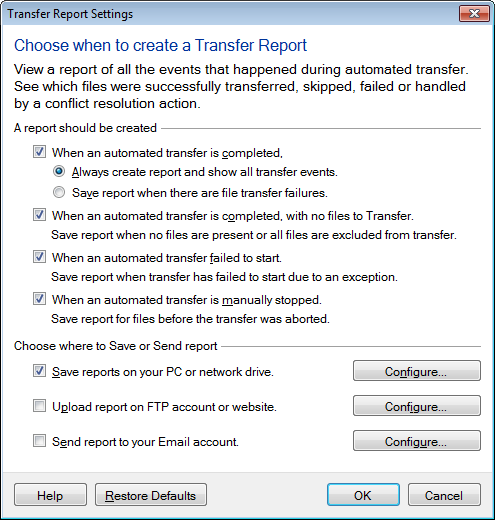
You can choose to save every report or just the one that was created when a file transfer failure occurred. Save location: Decide the location for saving the Transfer reports. You can choose any one or all of the following locations
-
PC or network drive
By default, the transfer reports will be saved on your PC in Documents >> Auto FTP Manager >> Transfer Reports. You have the option to change the default folder by clicking on Browse.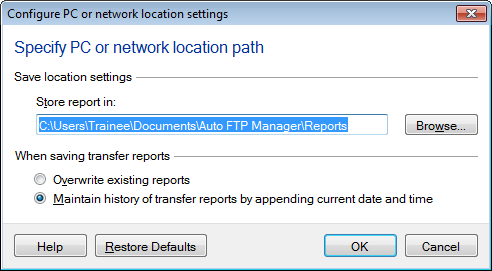
-
FTP
A remote location is always the safest option to save the important data. Your transfer report can be saved on FTP server. You just have to specify your FTP connection details and your transfer report is protected. FTP connection details include the server name or the FTP address, username, password, port number, and destination folder on the server.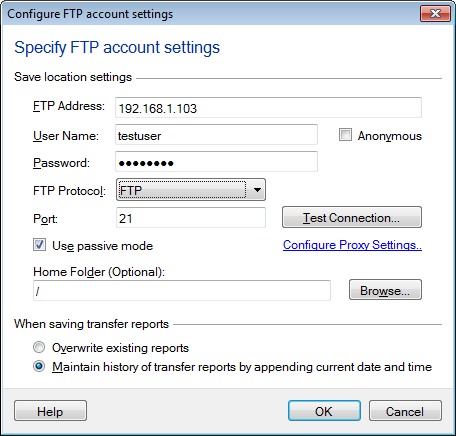
-
Email
If you chose to send the report as e-mail, enter the mail details. Mailing Information requires you to specify the email addresses of the sender and the receiver. You can include multiple receivers separated by a comma.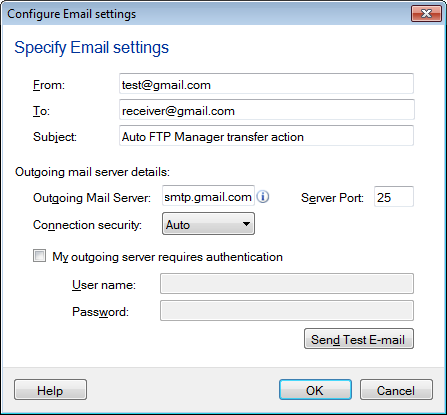
When saving transfer reports If you transfer files more frequently and are interested only in the latest transfer report, then choose the option Overwrite Transfer reports. Every time you perform automated transfer actions, the previous report is replaced with the new one. You can keep a track of all the reports by not deleting the previous one. Enable the option Maintain history of Transfer reports by appending current date and time.
-

